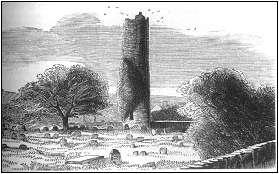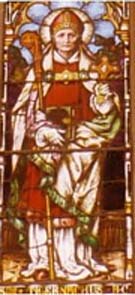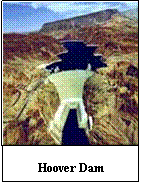Cumann
na gClann
Ui
Thighearnaigh
The Tierney Clans Society
 Welcome Page
Welcome Page
 Brief History
Brief History
 Clan Rally
Clan Rally
 Useful
Forms
Useful
Forms
 Archives
Archives
 Y-DNA Project
Y-DNA Project
 Links
Links
Newsletter Extracts
Contents
 Clan Newsletter Vol 2 Issue 2 April 2001
– St. Tighearnach’s Cemetry
Clan Newsletter Vol 2 Issue 2 April 2001
– St. Tighearnach’s Cemetry
 Clan Newsletter Vol 2 Issue
3 July 2001 – Patron Saint of The Tierney Clan
Clan Newsletter Vol 2 Issue
3 July 2001 – Patron Saint of The Tierney Clan
 Clan Newsletter Vol 2 Issue 3
July 2001 – Believe it or not!! (Hoover Dam)
Clan Newsletter Vol 2 Issue 3
July 2001 – Believe it or not!! (Hoover Dam)
 Clan Newsletter Vol 2 Issue 5
Jan 2002 – Clans Christmas Connection
Clan Newsletter Vol 2 Issue 5
Jan 2002 – Clans Christmas Connection
St
Tierney’s Cemetery
 Our
esteemed clan member Gilbert Tierney, France, mentioned
to me in a note that whilst traveling through the town of Clones in
County Monaghan, he
had come
across a cemetery named ‘St. Tierney’s Cemetery’. This intrigued me
and I had to investigate further. This cemetery is on the site of an old monastery
that was founded by
St. Tighearnach in the 6th century. The site
presently contains the ruins of a Church and a Round Tower. In the
town center of Clones there is a 9th century High Cross and this it
is thought stood near the
Round
Tower
originally. The Round
Tower
is retained to a height of 75 feet or 23 meters and has a square headed door
and windows. Nearby is a shrine in the shape of a house, with interesting
finials, called St. Tighearnach’s shrine. It is carved out of one stone.
Tradition says that there is a vault underneath it, “in which bodies were
placed having been taken from their coffins which were later destroyed beside
the shrine”. In the nearby churchyard is The Abbey that is a 12th
century nave of a nave-and-chancel church. It has a chancel arch and a
round-headed window. In the graveyard there are a number of 17th and
18th century gravestones, some of which bear an indication of the
profession of the person buried beneath, others having skulls, crossbones,
hourglasses etc.
Our
esteemed clan member Gilbert Tierney, France, mentioned
to me in a note that whilst traveling through the town of Clones in
County Monaghan, he
had come
across a cemetery named ‘St. Tierney’s Cemetery’. This intrigued me
and I had to investigate further. This cemetery is on the site of an old monastery
that was founded by
St. Tighearnach in the 6th century. The site
presently contains the ruins of a Church and a Round Tower. In the
town center of Clones there is a 9th century High Cross and this it
is thought stood near the
Round
Tower
originally. The Round
Tower
is retained to a height of 75 feet or 23 meters and has a square headed door
and windows. Nearby is a shrine in the shape of a house, with interesting
finials, called St. Tighearnach’s shrine. It is carved out of one stone.
Tradition says that there is a vault underneath it, “in which bodies were
placed having been taken from their coffins which were later destroyed beside
the shrine”. In the nearby churchyard is The Abbey that is a 12th
century nave of a nave-and-chancel church. It has a chancel arch and a
round-headed window. In the graveyard there are a number of 17th and
18th century gravestones, some of which bear an indication of the
profession of the person buried beneath, others having skulls, crossbones,
hourglasses etc.
Interesting
Tierneys
My interesting Tierney this issue must be the Clan
Patron Saint. As promised I have a resume on St, Tighearnach (also
spelt Tigernach,
Tihernach or Tighernach). According to tradition he was the
illegitimate son of Derfraych the foster daughter of Eochaidh, a chieftain in Limerick,
who was descended from the Colla-dá-Chrich, who were of the Airghailla Race.
His father was Cairbre who was of the race of Cathaoir Mór, King of Leinster,
descendant of Cathaoir Mór, High King of Ireland 120 A.D. to 123 A.D., who in
turn was the son of Feidhlimidh Firurghlais, who in turn was a descendant of
Tighearmas, High King of Ireland, from whom the name O’Tighearnaigh or
(O’)Tiern(e)y comes.
Tighearnach was captured by Welsh raiders
and taken to Britain. He later escaped and made his way to the monastery of Candida Casa
at Whithorn in Galloway, Scotland, where he received his education for the priesthood. He went on a
pilgrimage to Rome and is said to have brought from there to his native country relics
of the apostles Peter and Paul.
On his return to Ireland he established
a monastery at Clones, which was named the ‘Abbey of St. Peter and
St. Paul’. Some
sources state that, prior to this, he had been bishop of Clogher in Co. Tyrone.
He was renowned for raising the dead to life, which
he performed on several occasions. On one occasion he raised from the dead
Eithne, daughter of the King of Munster, who had taken her own life because she
had been unwillingly betrothed to a British prince. On another occasion it was
no less a person than Duach, Archbishop of Armagh.
St. Tighearnach died at Clones in 549. The ‘Annals of
Ireland’ writer by The Four Masters record the death of Diucuill, Abbot, inn
700 A.D. and in 714 A.D. they also record the death of another Abbot called
‘Cele-Tighearnach’ or, Servus Tighernachi’ or ‘the Servant of Tighearnach’,
proving at what an early date the name of the founder, ‘Tighearnach’, became
“invested with sanctity and honour”.
Of the
monastery there survives a handsome carved High Cross, situated in the Diamond
in Clones town, a Round Tower – now roofless, and fragments of a Romanesque
church and a tomb, all described in the last issue.
The life of St. Tighearnach in Latin can be found in
the ‘Acta Sanctorum’ at the 5th April, and on this day we celebrate
his Feast-day, a special day for the Clan.
Whilst browsing through various books in an effort to
learn about St. Tighearnach of Clones, I was amazed to come across not just one
St. Tighearnach but several. The following is a list; St. Tighearnach of
Doire-Melle (in Co. Leitrim) Nov. 4th; St. Tighearnach, priest Mar.
17th; Tighearnach Abbot of Killeigh who died in 805 A.D.;
Tighearnach Abbot of Fennor died 837; Tighearnach Abbot of Dromiskin died 876;
Tighearnach Boirceach Abbot of Moville died 1061; Tighearnach Uí Bhrian the
Annalist died 1088. Not all were of the Tierney ‘Célte’, but we are pretty
certain that St. Tighearnach of Clones was.
Back to
top
Believe it or
not!
The Hoover Dam is situated in
Black Canyon on the Colorado
River, about 30 miles southeast of
Las Vegas, Nevada.
Originally called Boulder Dam, this
 engineering
marvel was re-named for Herbert Hoover, the 31st President of the United States. Construction of Hoover Dam began in 1931, and the last
concrete was poured in 1935, two years ahead of schedule. President Franklin D. Roosevelt dedicated the dam on September 30,1935. The
power plant structures were completed in 1936, and the first generator began commercial operation in October of that year. The 17th and final generator went
into commercial operation in 1961. Hoover Dam was without precedent, the greatest dam
constructed in its day. An arch-gravity structure rising 726 feet above bedrock. It is 660 feet thick at its base, 45 feet thick at its crest, and stretches
1,244 feet across the Black
Canyon.
There are 4.4 million cubic yards of concrete in the dam, power plant and
related structures.
engineering
marvel was re-named for Herbert Hoover, the 31st President of the United States. Construction of Hoover Dam began in 1931, and the last
concrete was poured in 1935, two years ahead of schedule. President Franklin D. Roosevelt dedicated the dam on September 30,1935. The
power plant structures were completed in 1936, and the first generator began commercial operation in October of that year. The 17th and final generator went
into commercial operation in 1961. Hoover Dam was without precedent, the greatest dam
constructed in its day. An arch-gravity structure rising 726 feet above bedrock. It is 660 feet thick at its base, 45 feet thick at its crest, and stretches
1,244 feet across the Black
Canyon.
There are 4.4 million cubic yards of concrete in the dam, power plant and
related structures.
The dam controls floods while it stores water for irrigation, municipal, and industrial
uses. The dam also provides hydroelectric power
generation, recreation and fish and wildlife habitat.But,
more interesting than the facts and figures of the Hoover Dam’s construction are
the people who made the d am
possible – the workmen, and an interesting story of the first and last men to
die on the project. It goes something like this. On December 20, 1922,
J. G. Tierney, a Bureau of Reclamation employee engaged in a geological survey
from a barge in the Colorado River
fell in the river and drowned. Thirteen years to the day,
on December 20, 1935,
Patrick W. Tierney, a Bureau of Reclamation employee and son of J. G. Tierney,
fell from one of the intake towers.
What
has all this got to do with Tierney! This story has become
folklore because of the relation between the two men and the thirteen years that
separate their deaths, but there is a certain amount of artistic license in the
tale. First, the dam was built from 1931 to 1935, so J.
G. Tierney was not really involved in the "construction"
of the dam. He was doing a geological survey to decide where the dam would be
built, but he was not the first person doing the survey to die. On May 15, 1922, Harold Connelly, also fell off of a barge and drowned. So, why
isn't he considered the first person to die on the project? Well, for one thing
it would not make as good a story as the Tierney family. To get around this
people point out that Connelly died while surveying a canyon upstream from the
present site of the dam, while both Tierneys died in the canyon where the dam
was eventually built.
am
possible – the workmen, and an interesting story of the first and last men to
die on the project. It goes something like this. On December 20, 1922,
J. G. Tierney, a Bureau of Reclamation employee engaged in a geological survey
from a barge in the Colorado River
fell in the river and drowned. Thirteen years to the day,
on December 20, 1935,
Patrick W. Tierney, a Bureau of Reclamation employee and son of J. G. Tierney,
fell from one of the intake towers.
What
has all this got to do with Tierney! This story has become
folklore because of the relation between the two men and the thirteen years that
separate their deaths, but there is a certain amount of artistic license in the
tale. First, the dam was built from 1931 to 1935, so J.
G. Tierney was not really involved in the "construction"
of the dam. He was doing a geological survey to decide where the dam would be
built, but he was not the first person doing the survey to die. On May 15, 1922, Harold Connelly, also fell off of a barge and drowned. So, why
isn't he considered the first person to die on the project? Well, for one thing
it would not make as good a story as the Tierney family. To get around this
people point out that Connelly died while surveying a canyon upstream from the
present site of the dam, while both Tierneys died in the canyon where the dam
was eventually built.
Back to top
Our
Christmas Connection!
Did you know that the Tierney Plant Badge is the
Holly?
We
do not as yet know why this is so but the Holly was a very sacred tree in ancient
Celtic Ireland. Holly has been used as a decoration representing good will
and rejoicing throughout the ages. [Maybe this is why it is designated as
the Tierney plant. For doesn’t everyone know that we Tierneys are full of good
will towards all and we love to rejoice – give us any excuse for a party!] There are many legends about this
evergreen tree with its shiny leaves and bright red berries.
throughout the ages. [Maybe this is why it is designated as
the Tierney plant. For doesn’t everyone know that we Tierneys are full of good
will towards all and we love to rejoice – give us any excuse for a party!] There are many legends about this
evergreen tree with its shiny leaves and bright red berries.
One legend associates the holly with the burning bush
Moses encountered in the wilderness. Another tells us that Christ’s crown of
thorns was woven from holly, and before the crucifixion the plant bore white
berries, which later turner to crimson.
On the night that the holy family fled out of
Bethlehem, when King
Herod’s soldiers were very close, legend tells us that Mary and Joseph hid the
Baby Jesus under a holly bush until the danger had passed. The Christ
Child blessed the holly so that it would remain forever green – a symbol of
immortality. Ever since then, the evergreen holly has been associated with the
promise of everlasting life.
Back to top
 Welcome Page
Welcome Page
 Forms
Forms
 Clan Rally
Clan Rally
 Brief History
Brief History
 Archives
Archives
 Y-DNA Project
Y-DNA Project
 Links
Links
All material contained in this website is
the property of The Tierney Clan Society and is subject to copyright ©2000-07
Cumann na gClann Uí
Thighearnaigh – The Tierney Clans Society.
For problems or
questions regarding this site, and especially if a link does not work,
please contact
otighearnaigh@eircom.net
Last updated
Eanáir 2007.
![]() Welcome Page
Welcome Page
![]() Brief History
Brief History
![]() Clan Rally
Clan Rally
![]() Useful
Forms
Useful
Forms
![]() Archives
Archives
![]() Y-DNA Project
Y-DNA Project![]() Links
Links![]() Clan Newsletter Vol 2 Issue 2 April 2001
– St. Tighearnach’s Cemetry
Clan Newsletter Vol 2 Issue 2 April 2001
– St. Tighearnach’s Cemetry![]() Clan Newsletter Vol 2 Issue
3 July 2001 – Patron Saint of The Tierney Clan
Clan Newsletter Vol 2 Issue
3 July 2001 – Patron Saint of The Tierney Clan![]() Clan Newsletter Vol 2 Issue 3
July 2001 – Believe it or not!! (Hoover Dam)
Clan Newsletter Vol 2 Issue 3
July 2001 – Believe it or not!! (Hoover Dam)![]() Clan Newsletter Vol 2 Issue 5
Jan 2002 – Clans Christmas Connection
Clan Newsletter Vol 2 Issue 5
Jan 2002 – Clans Christmas Connection Our
esteemed clan member Gilbert Tierney, France, mentioned
to me in a note that whilst traveling through the
Our
esteemed clan member Gilbert Tierney, France, mentioned
to me in a note that whilst traveling through the
 engineering
marvel was re-named for Herbert Hoover, the 31st President of the
engineering
marvel was re-named for Herbert Hoover, the 31st President of the  am
possible – the workmen, and an interesting story of the first and last men to
die on the project. It goes something like this. On
am
possible – the workmen, and an interesting story of the first and last men to
die on the project. It goes something like this. On 
![]() Welcome Page
Welcome Page
![]() Forms
Forms
![]() Clan Rally
Clan Rally
![]() Brief History
Brief History
![]() Archives
Archives
![]() Y-DNA Project
Y-DNA Project![]() Links
Links